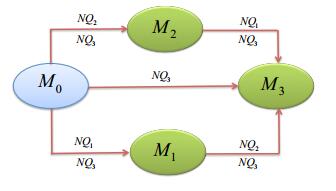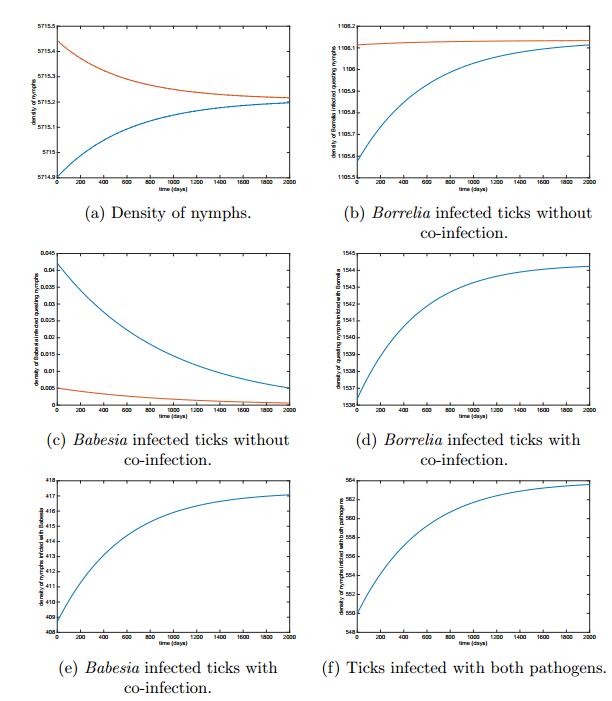|
[1]
|
[ M. E. Adelson,R. V. S. Rao,R. C. Tilton, Prevalence of Borrelia burgdorferi, Bartonella spp., Babesia microti, and Anaplasma phagocytophila in Ixodes scapularis ticks collected in Northern New Jersey, J. Cli. Micro., 42 (2004): 2799-2801.
|
|
[2]
|
[ F. R. Adler,J. M. Pearce-Duvet,M. D. Dearing, How host population dynamics translate into time-lagged prevalence: An investigation of Sin Nombre virus in deer mice, Bull. Math. Biol., 70 (2008): 236-252.
|
|
[3]
|
[ C. Alvey,Z. Feng,J. Glasser, A model for the coupled disease dynamics of HIV and HSV-2 with mixing among and between genders, Math. Biosci., 265 (2015): 82-100.
|
|
[4]
|
[ E. A. Belongia, Epidemiology and impact of coinfections acquired from Ixodes ticks, Vector-Borne and Zoonotic Dis., 2 (2002): 265-273.
|
|
[5]
|
[ O. Diekmann,J. A. P. Heesterbeek,M. G. Roberts, The construction of next-generation matrices for compartmental epidemic models, J. R. Soc. Interface, 5 (2009): 1-13.
|
|
[6]
|
[ M. A. Diuk-Wasser,E. Vannier,P. J. Krause, Coinfection by Ixodes tick-borne pathogens: Ecological, epidemiological, and clinical consequences, Trends Para., 32 (2016): 30-42.
|
|
[7]
|
[ P. van den Driessche,J. Watmough, Reproduction numbers and sub-threshold endemic equilibria for compartmental models of disease transmission, Math. Biosci., 180 (2002): 29-48.
|
|
[8]
|
[ G. Fan,Y. Lou,H. R. Thieme,J. Wu, Stability and persistence in ODE models for populations with many stages, Math. Biosci. Eng., 12 (2015): 661-686.
|
|
[9]
|
[ G. Fan,H. R. Thieme,H. Zhu, Delay differential systems for tick population dynamics, J. Math. Biol., 71 (2015): 1017-1048.
|
|
[10]
|
[ D. Gao,Y. Lou,S. Ruan, A periodic Ross-Macdonald model in a patchy environment, Dis. Cont. Dyn. Syst.-B, 19 (2014): 3133-3145.
|
|
[11]
|
[ D. Gao,T. C. Porco,S. Ruan, Coinfection dynamics of two diseases in a single host population, J. Math. Anal. Appl., 442 (2016): 171-188.
|
|
[12]
|
[ E. J. Goldstein,C. Thompson,A. Spielman,P. J. Krause, Coinfecting deer-associated zoonoses: Lyme disease, babesiosis, and ehrlichiosis, Clin. Inf. Dis., 33 (2001): 676-685.
|
|
[13]
|
[ L. Halos,T. Jamal,R. Maillard, Evidence of Bartonella sp. in questing adult and nymphal Ixodes ricinus ticks from France and co-infection with Borrelia burgdorferi sensu lato and Babesia sp., Veterinary Res., 361 (2005): 79-87.
|
|
[14]
|
[ J. M. Heffernan,Y. Lou,J. Wu, Range expansion of Ixodes scapularis ticks and of Borrelia burgdorferi by migratory birds, Dis. Cont. Dyn. Syst.-B, 19 (2014): 3147-3167.
|
|
[15]
|
[ M. H. Hersh, R. S. Ostfeld and D. J. McHenry et al., Co-infection of blacklegged ticks with Babesia microti and Borrelia burgdorferi is higher than expected and acquired from small mammal hosts, PloS one, 9 (2014), e99348.
|
|
[16]
|
[ M. W. Hirsch,H. L. Smith,X.-Q. Zhao, Chain transitivity, attractivity and strong repellors for semidynamical systems, J. Dyn. Differ. Equ., 13 (2001): 107-131.
|
|
[17]
|
[ Y. Lou, J. Wu and X. Wu, Impact of biodiversity and seasonality on Lyme-pathogen transmission, Theo. Biol. Med. Modell., 11 (2014), 50.
|
|
[18]
|
[ Y. Lou,X.-Q. Zhao, Modelling malaria control by introduction of larvivorous fish, Bull. Math. Biol., 73 (2011): 2384-2407.
|
|
[19]
|
[ P. D. Mitchell,K. D. Reed,J. M. Hofkes, Immunoserologic evidence of coinfection with Borrelia burgdorferi, Babesia microti, and human granulocytic Ehrlichia species in residents of Wisconsin and Minnesota, J. Cli. Biol., 34 (1996): 724-727.
|
|
[20]
|
[ S. Moutailler, C. V. Moro and E. Vaumourin et al., Co-infection of ticks: The rule rather than the exception, PLoS Negl. Trop. Dis., 10 (2016), e0004539.
|
|
[21]
|
[ J. M. Mutua,F. B. Wang,N. K. Vaidya, Modeling malaria and typhoid fever co-infection dynamics, Math. Biosci., 264 (2015): 128-144.
|
|
[22]
|
[ N. H. Ogden, L. St-Onge and I. K. Barker et al., Risk maps for range expansion of the Lyme disease vector, Ixodes scapularis in Canada now and with climate change, Int. J. Heal. Geog., 7 (2008), 24.
|
|
[23]
|
[ A. R. Plourde,E. M. Bloch, A literature review of Zika virus, Emerg. Inf. Dise., 22 (2016): 1185-1192.
|
|
[24]
|
[ H. C. Slater, M. Gambhir, P. E. Parham and E. Michael, Modelling co-infection with malaria and lymphatic filariasis, PLoS Comput. Biol., 9 (2013), e1003096, 14pp.
|
|
[25]
|
[ H. L. Smith,
Monotone Dynamical Systems: An Introduction to the Theory of Competitive and Cooperative Systems, Providence, RI: Math. Surveys Monogr., 41, AMS, 1995.
|
|
[26]
|
[ F. E. Steiner,R. R. Pinger,C. N. Vann, Infection and co-infection rates of Anaplasma phagocytophilum variants, Babesia spp., Borrelia burgdorferi, and the rickettsial endosymbiont in Ixodes scapularis (Acari: Ixodidae) from sites in Indiana, Maine, Pennsylvania, and Wisconsin, J. Med. Entom., 45 (2008): 289-297.
|
|
[27]
|
[ G. Stinco,S. Bergamo, Impact of co-infections in Lyme disease, Open Dermatology J., 10 (2016): 55-61.
|
|
[28]
|
[ S. J. Swanson,D. Neitzel,K. D. Reed,E. A. Belongia, Coinfections acquired from Ixodes ticks, Cli. Micro. Rev., 19 (2006): 708-727.
|
|
[29]
|
[ B. Tang, Y. Xiao and J. Wu, Implication of vaccination against dengue for Zika outbreak, Sci. Rep., 6 (2016), 35623.
|
|
[30]
|
[ H. R. Thieme, Convergence results and a Poincare-Bendixson trichotomy for asymptotically autonomous differential equations, J. Math. Biol., 30 (1992): 755-763.
|
|
[31]
|
[ W. Wang,X.-Q. Zhao, Spatial invasion threshold of Lyme disease, SIAM J. Appl. Math., 75 (2015): 1142-1170.
|
|
[32]
|
[ X. Wu,V. R. Duvvuri,Y. Lou, Developing a temperature-driven map of the basic reproductive number of the emerging tick vector of Lyme disease Ixodes scapularis in Canada, J. Theo. Biol., 319 (2013): 50-61.
|
|
[33]
|
[ X. -Q. Zhao,
Dynamical Systems in Population Biology, New York: Springer, 2003.
|
|
[34]
|
[ X.-Q. Zhao,Z. Jing, Global asymptotic behavior in some cooperative systems of functional-differential equations, Canad. Appl. Math. Quart., 4 (1996): 421-444.
|















 DownLoad:
DownLoad: